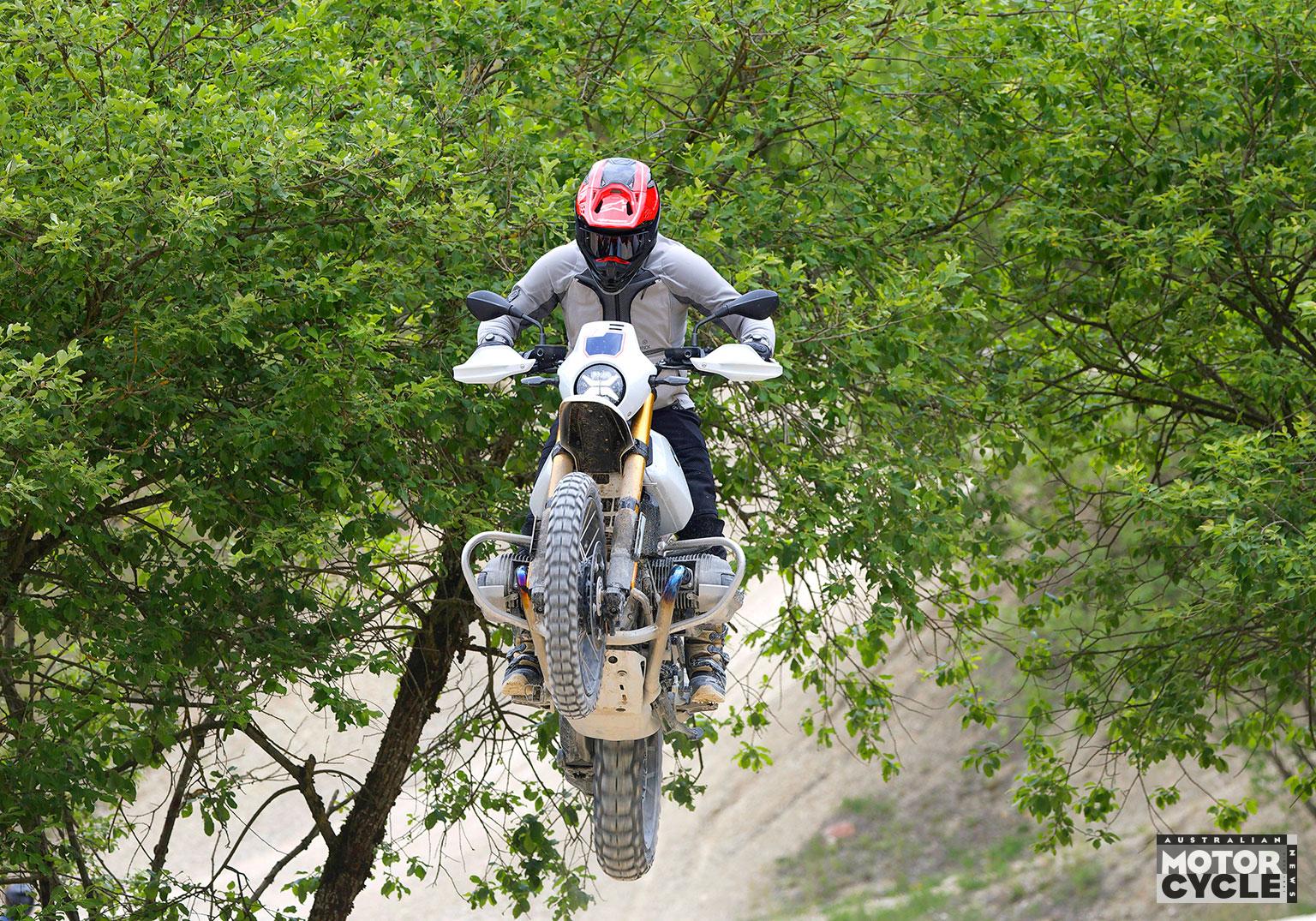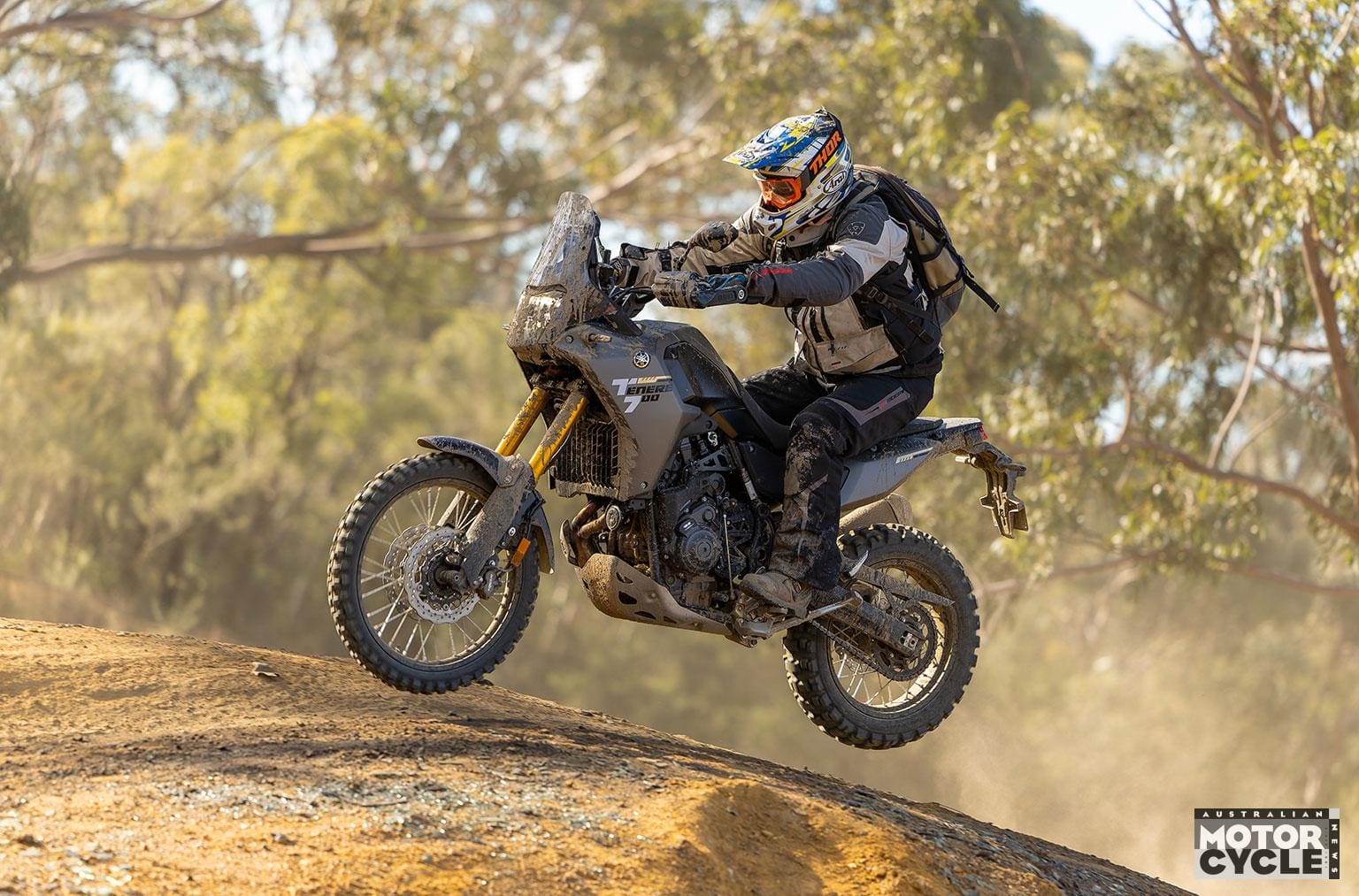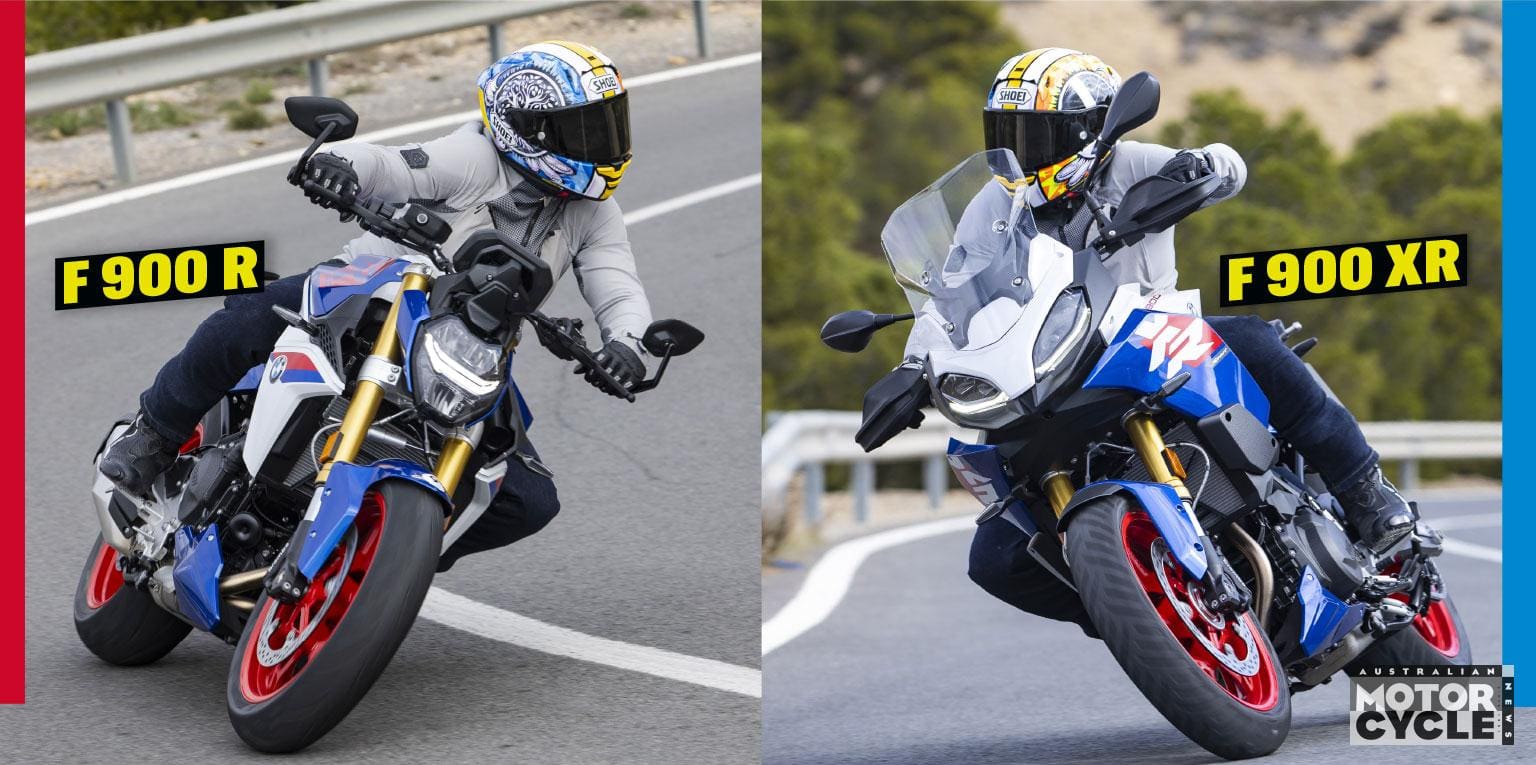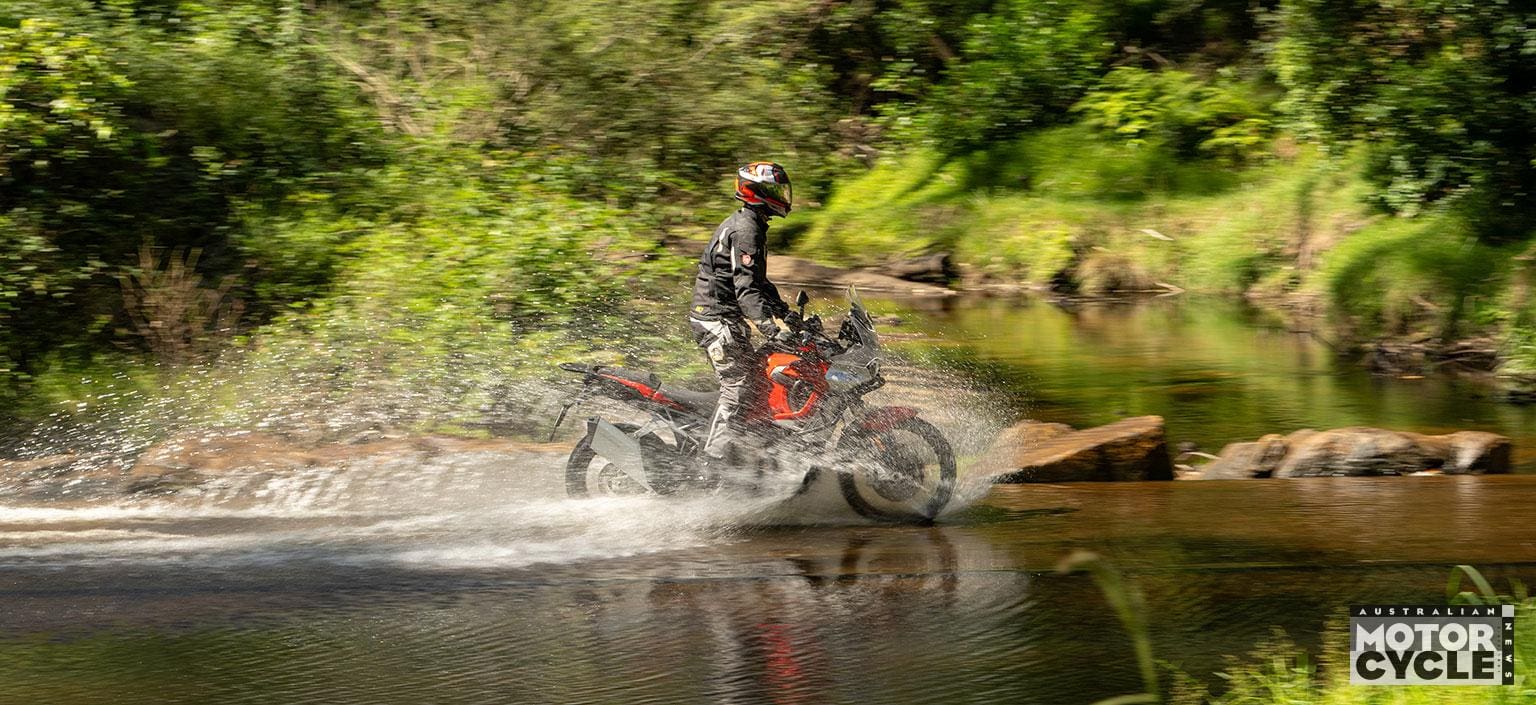Even with the shortest test rider AMCN has to offer, BMW’s huge new R 1300 GS Adventure is ready to take on anything.
It should come as no surprise that just one year after launching the all-new and highly acclaimed BMW R 1300 GS, BMW has introduced the R 1300 GS Adventure, a go-anywhere, do-anything GS ultimate, complete with a 30-litre fuel tank and a distinctive look that is quite the talk of the adventure bike community.
Putting the new styling to one side for a moment, the Adventure is far more than a GS with a colossally large tank. In fact, BMW stresses that it’s a new model in its own right, offering something different to the standard R 1300 GS. The lightweight frame first seen on the R 1300 GS remains but attached is a completely new subframe for a greater payload and more room for both rider and pillion. The EVO suspension is similar but has revised settings to compensate for the Adventure’s extra weight and suspension travel (210mm front, 220mm rear).

The wheelbase extends, there’s more weather and crash protection and, as we’ve heard, the fuel tank is as big as some car’s. There are four model variants, a new catalogue of optional extras and, for the first time in GS Adventure history, an optional automatic gearbox care of Automated Shift Assistant (ASA) technology.
BMW provided us with two days of touring in southern Spain both on road and off, and on two models (the GSA TE ESA and the Trophy), with both manual and automatic transmission. AMCN sent one of the shortest road testers in the industry to ride one of the tallest and largest adventure bikes ever seen.

The ride
First, let’s deal with the large, grey and trunky mammal in the room: the looks and sheer size of the new GS Adventure. The internet went into minor meltdown when BMW first unveiled images; the planet, if not the entire universe, was outraged by its distinctive and rather boxy design, a clear result of BMW wanting to create a divide between the standard R 1300 GS and the Adventure.
Certainly, you can no longer confuse the two. The Adventure now stands alone as its own not-so-discrete self. Like many looking at images on phone and laptop, I was a little unsure at first – but in the flesh it somehow works. I also like the fact that it is completely different from any other bike on the market. BMW, as ever, are going their own way with this bike.
The internet is correct on one thing: it is intimidating. But isn’t it supposed to be? For the record, I’m not quite 5ft 7in (170cm) tall and BMW politely asked if I wanted the lower seat, which I just as politely declined, preferring to test the standard seat, which ranges from 870mm to 890mm, 20mm higher than the standard R 1300 GS. In fact, I spent the majority of the test on the Trophy with the Enduro seat 895mm/915mm. However, tick the option box for the adaptive vehicle height control and this automatically lowers the seat by another 30mm when it comes to a halt.
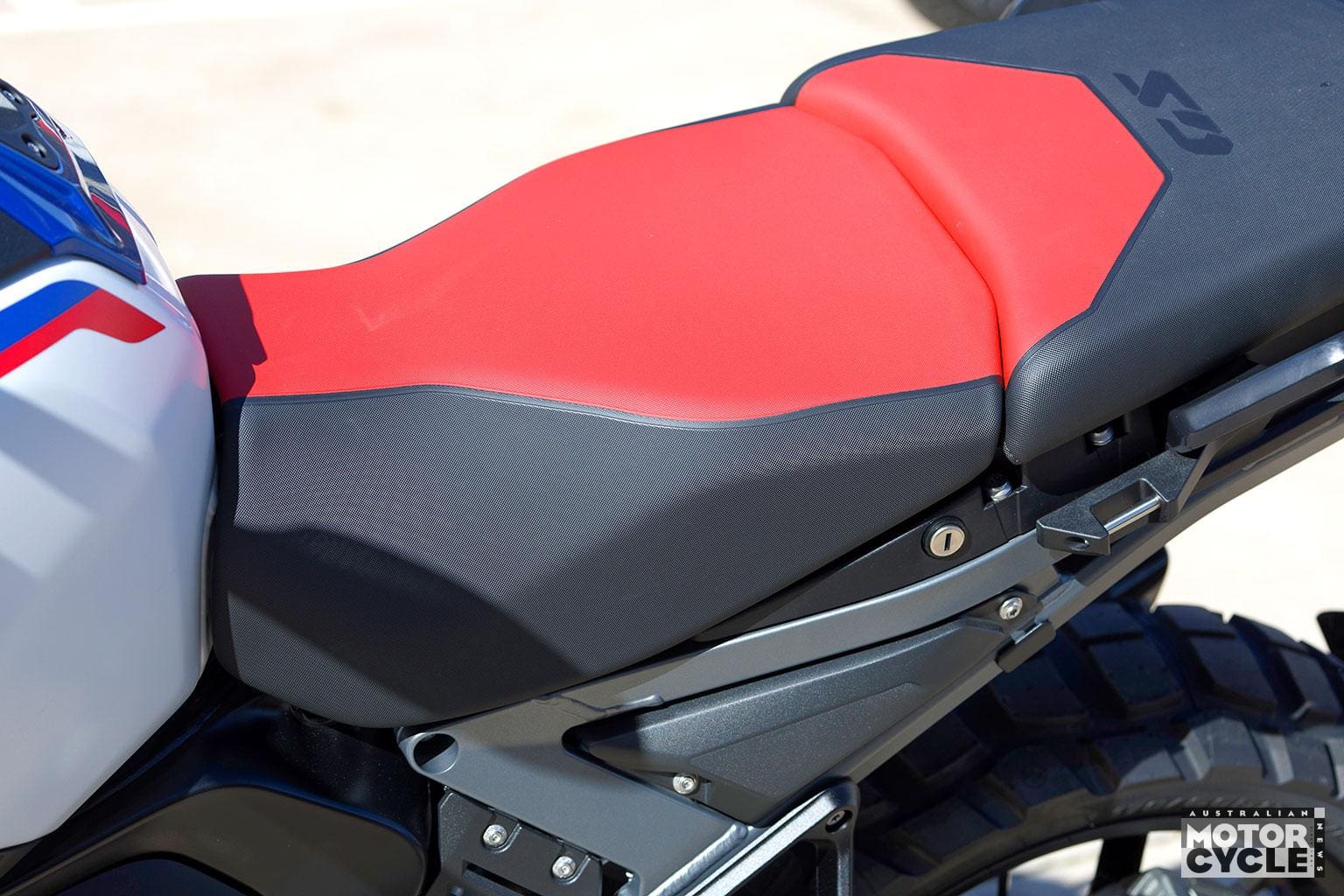
You may be able to make the Adventure lower but you can’t make it smaller. Throwing a leg over the full-height Trophy variant, complete with its 895mm-tall Enduro seat, revealed a massive motorcycle, especially with useful radiator-cowl side bags fitted. With the bike upright, I was on tiptoes, but just about secure enough to feel confident. Alternatively, I could slide one leg across, get one foot securely down, and was still able to reach the back brake or gear selector with the opposite foot.
Using the adaptive vehicle height control on the standard 870mm seat makes a difference: with it activated I could reach the ground securely with both feet, although I still wasn’t flat-footed – this on the standard seat but now lowered to 850mm.
But, predictably, as soon as the wheels were turning, the dauting bulk of the Adventure became a distant memory. Like every GS boxer I’ve ridden, there’s a lovely natural balance to the way it rolls. At slow speeds, even walking pace, it spoon-fed me confidence and made me feel like a different person. The extra-wide fuel tank is a constant reminder that the Adventure weighs 269kg (before extras like luggage), yet at just 5km/h it seems to weigh nothing at all.
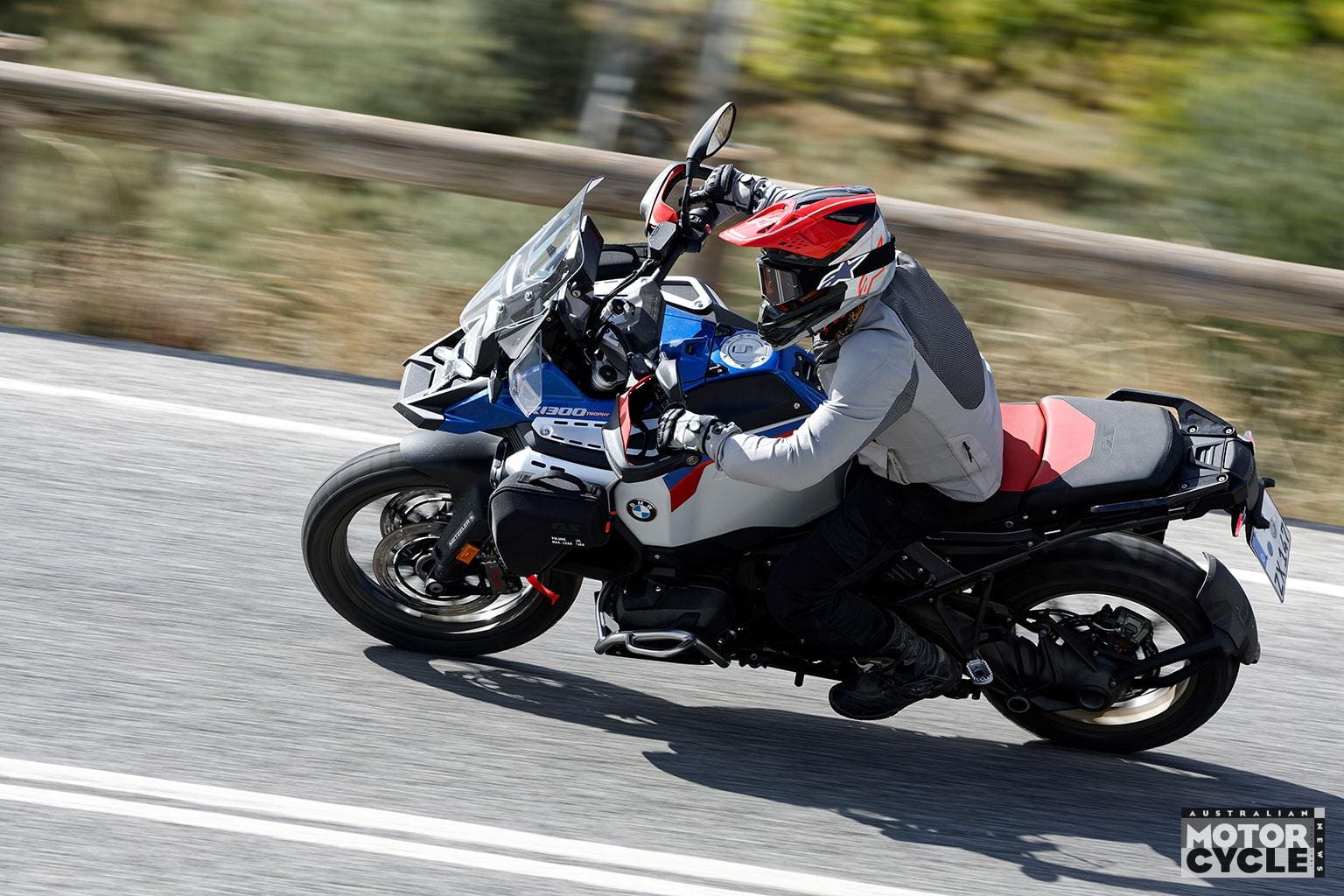
I’m familiar with the GS and the BMW brand, meaning the wide 6.5inch TFT display with its navigation wheel on the left bar quickly became second nature. I still rate the GS dash and switchgear as the best on the market. Thankfully BMW hasn’t changed this proven recipe on the 1300 Adventure.
There are four standard riding modes and a large raft of rider aids – then it’s just a question of how many boxes you ticked in the accessories pack. You can, for example, opt for up to seven riding modes by adding Dynamic, Dynamic Pro and Enduro Pro to the standard Eco, Road, Enduro and Rain. Gearshift Assist Pro, which allows almost seamless up and down shifts, is an optional extra that I believe should be standard. You could opt for the very clever and easy-to-use Active Cruise Control (ACC), which incorporates Lane Change Warning and the Rear End Collision Warning (RECW). There are screen options, multiple luggage and top case choices… The options seem endless. The configurator will make you giddy.
In what felt like no time at all, we hit the dusty trails that are common to Andalusia. It’s a big ask to make such a large bike work off-road, and that enormous petrol tank restricts your movement slightly when you’re standing on the (grippy) pegs, but the chassis and suspension absorbed the bike’s weight far better than I was expecting. That sweet boxer balance that works so well in town and carparks means it will crawl along at less than walking pace on dirt too, while you plan your next move. The fuelling in the off-road Enduro and Enduro Pro modes is all but perfect. Off-road as well as on-road, the GS is nowhere near as intimidating as you’d think.
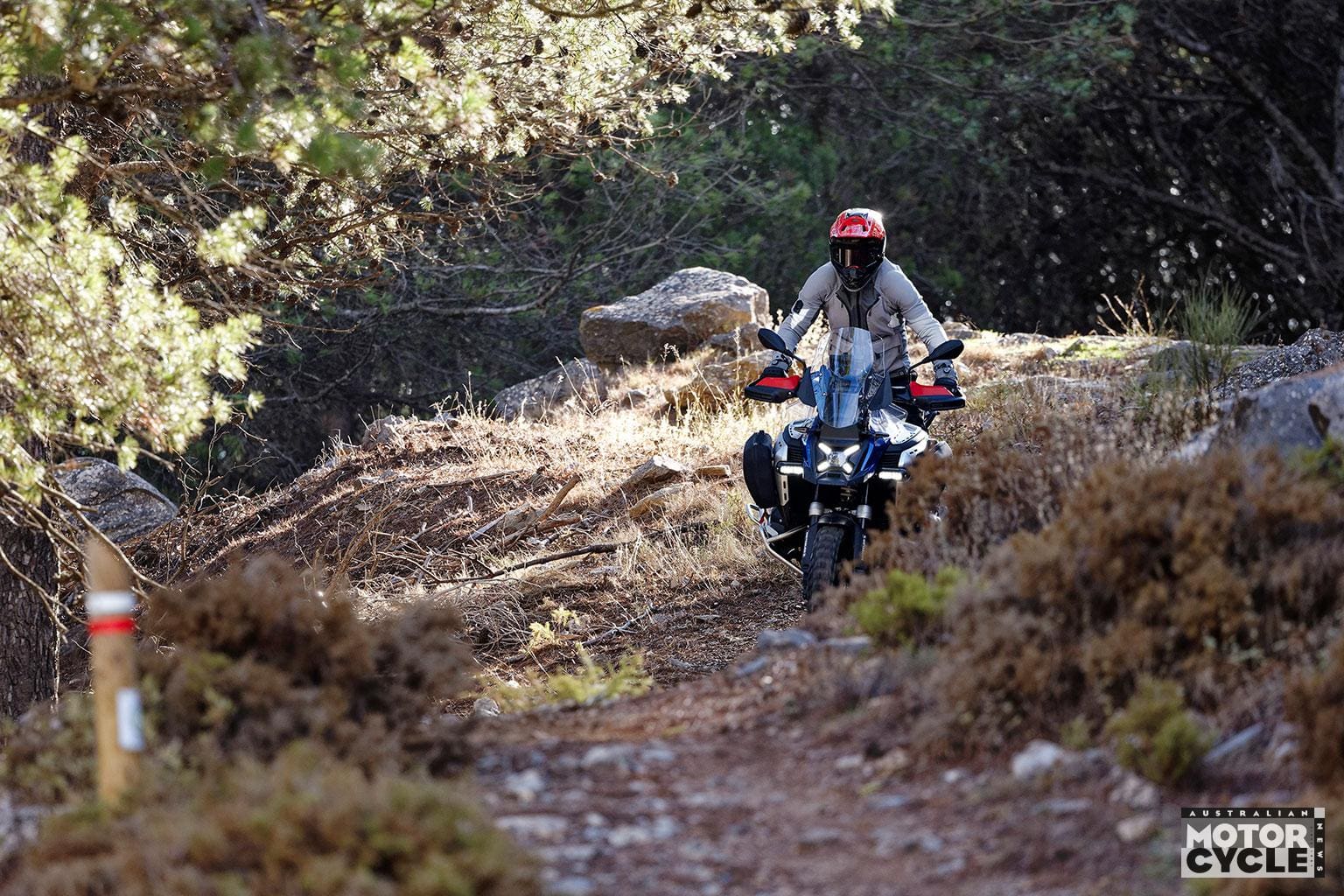
Some of the trails on our test route were wide and open, allowing for 100km/h progress in relative safety. The Adventure threw up curtains of dust on the long sweeping corners while giving me great vison ahead. In the optional Enduro Pro mode you can play with the rider aids, reducing the traction control (TC) or removing the ABS from the rear. Most riders will want the added security of the off-road-biased rider aids as these are excellent at keeping everything in order while encouraging you to have fun. You can play with the rear wheel grip like the Adventure is a toy. Aggressive throttle inputs send the rear tyre spinning but there’s always control. Add some lean or counter-steering and you’re rewarded with a delicious progressive slide that looks and feels awesome.
Get too carried away and the TC reduces the power and brings the wheels back in line. No bangs, pops or misfires – just velvet smooth control. It’s like riding with an off-road expert on the pillion seat, who lets you know when it’s time to back off. Once you get used to the feeling of the TC recovering the slide, you can’t help trying to beat the system, sliding against the TC, using the brilliance of the Adventure’s electronic off-road as a safety net.
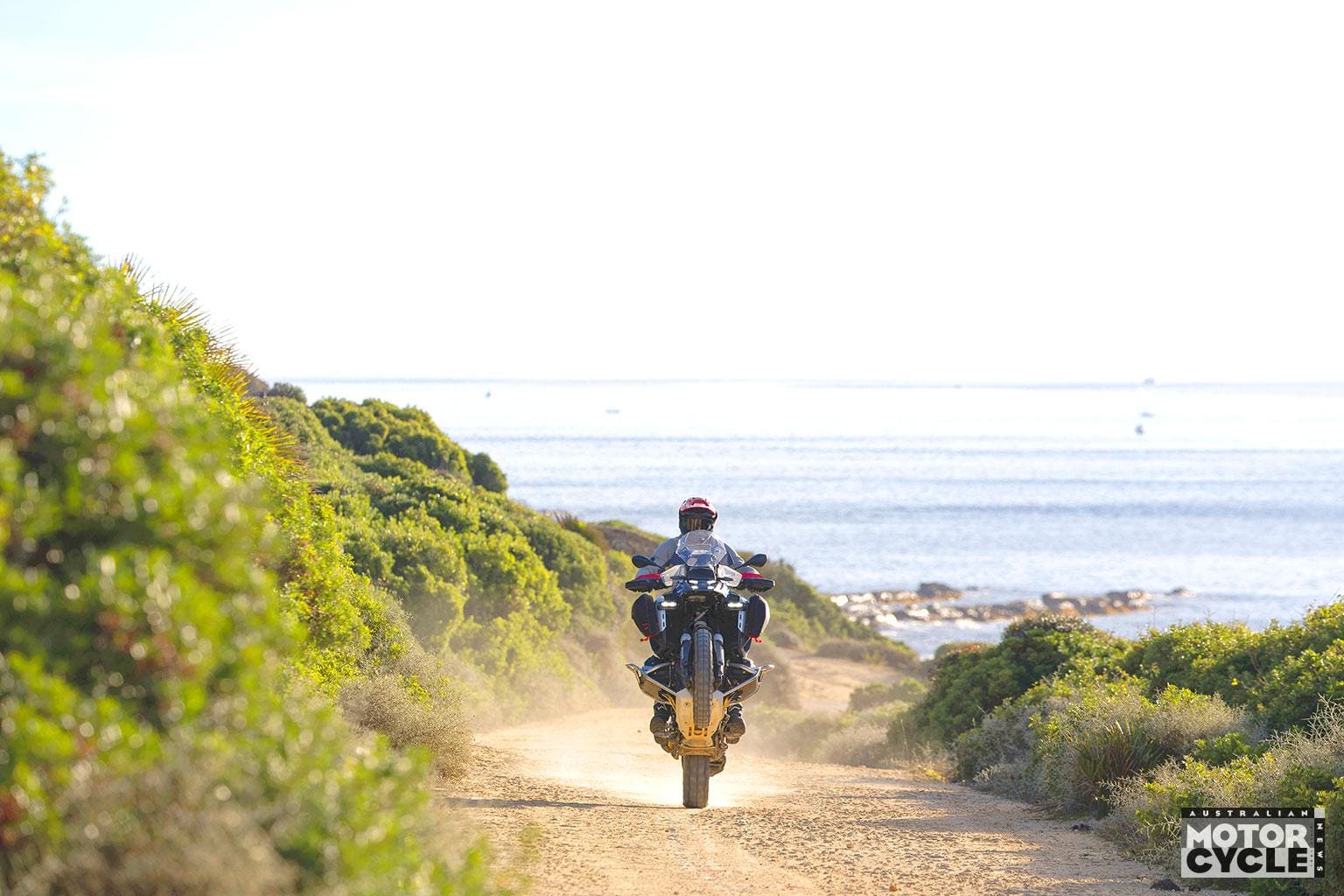
It’s the same story for the off-road ABS-assisted brakes, which manage to find grip where you didn’t think it existed. Stopping a 269kg-plus load from 100km/h-plus on gravel and dust takes some doing, but the ABS is forensically excellent. You can feel it working to find grip, which boosts confidence and makes brisk off-road riding more enjoyable and relaxing. With the Enduro Package fitted, the Trophy is near faultless on the trail for the average rider.
A note of warning, though. It’s a bit too easy to forget that it’s not, in my case especially, natural talent making the Adventure pull off wide-open rooster-tailed power slides like an enduro ace – it is BMW’s electronic boffins. I got so excited that I turned off the TC and nearly got caught out. When the Adventure starts to slide without electronic intervention on tap, it just keeps going. Try to bring the wheels back into line and it swings from side to side like a 140hp/269kg pendulum. You also feel that weight after a while, especially with a full tank of petrol. As much as I enjoyed the GS on the endless dusty trails, the next day my stiff and aching arms told me it was physically hard graft too.
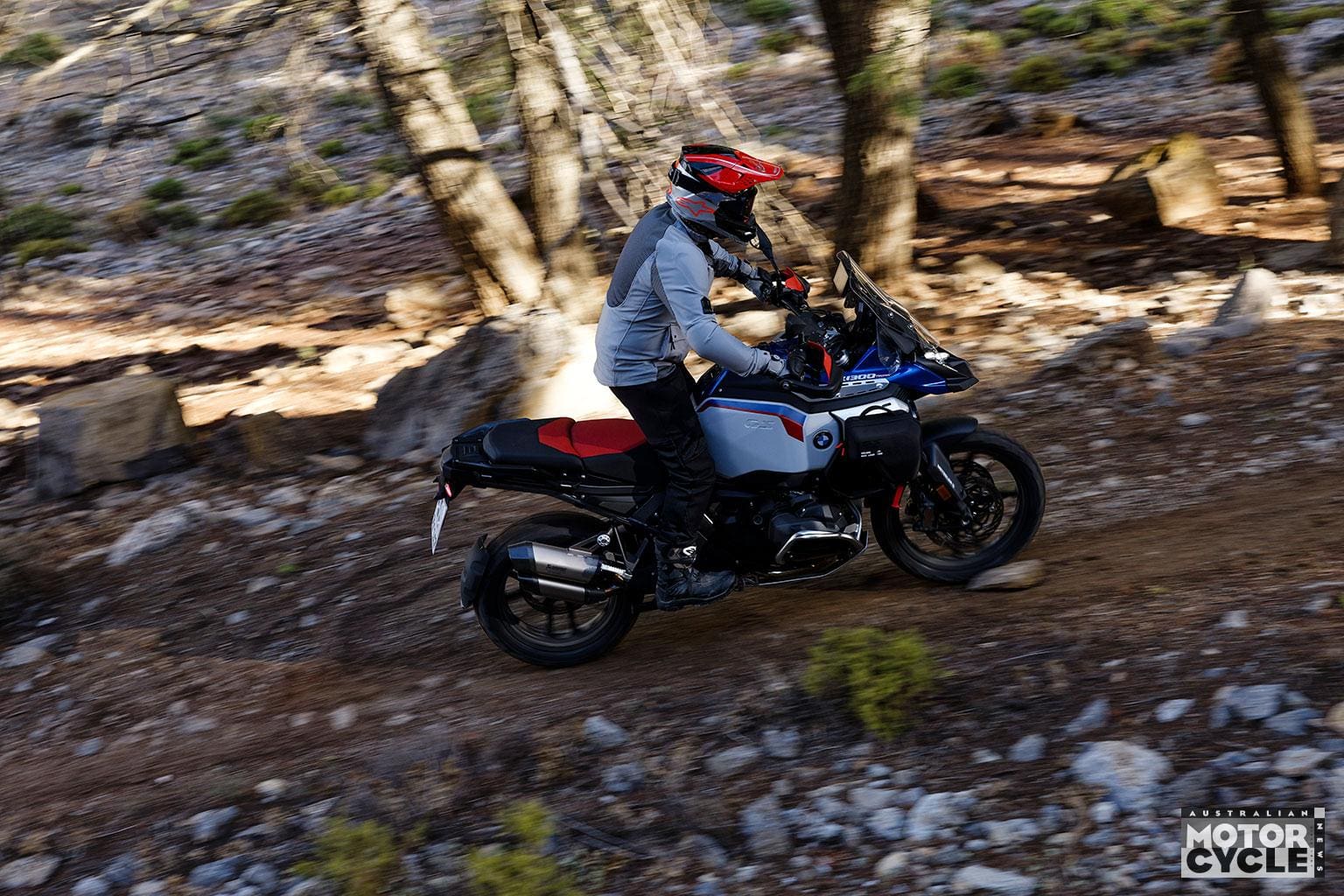
But I loved it. While anyone who rides a lightweight, single-cylinder enduro bike will think the Adventure handles like a boat, and real experts will find the ABS too intrusive; those of us who regularly ride big adventure bikes on roads and trails will be surprised by what the BMW is capable of. There’s even excellent crash protection should you get carried away – or fall over at a standstill, which, with one foot in a rut, can happen.
Back on the asphalt, the compliments kept on coming. In Road mode the ride quality prioritises comfort over performance, via the Dynamic Suspension Adjustment (DSA). As it’s so comfortable and softly damped, it really shouldn’t handle as well as it does, but the DSA takes everything in its stride and makes the ride effortless. We encountered some uneven roads with bumps and even exposed tree roots breaking through the surface, but the implacable Adventure absorbed everything in its path, stability unchallenged. I could see the suspension of the bike in front working overtime – the Evo suspension has more travel than the standard GS – but the rider remained unfazed and in control. It’s like the swan swimming against a strong current, legs frantically going like crazy below the water, but graceful above the waterline.
When the pace hots up, you need to flick into the Dynamic or Dynamic Pro modes, which gives the Adventure more support and a tauter ride. There’s noticeably less suspension travel and also more feel coming back from the tyres, meaning you can push on a little harder and enjoy the potential.
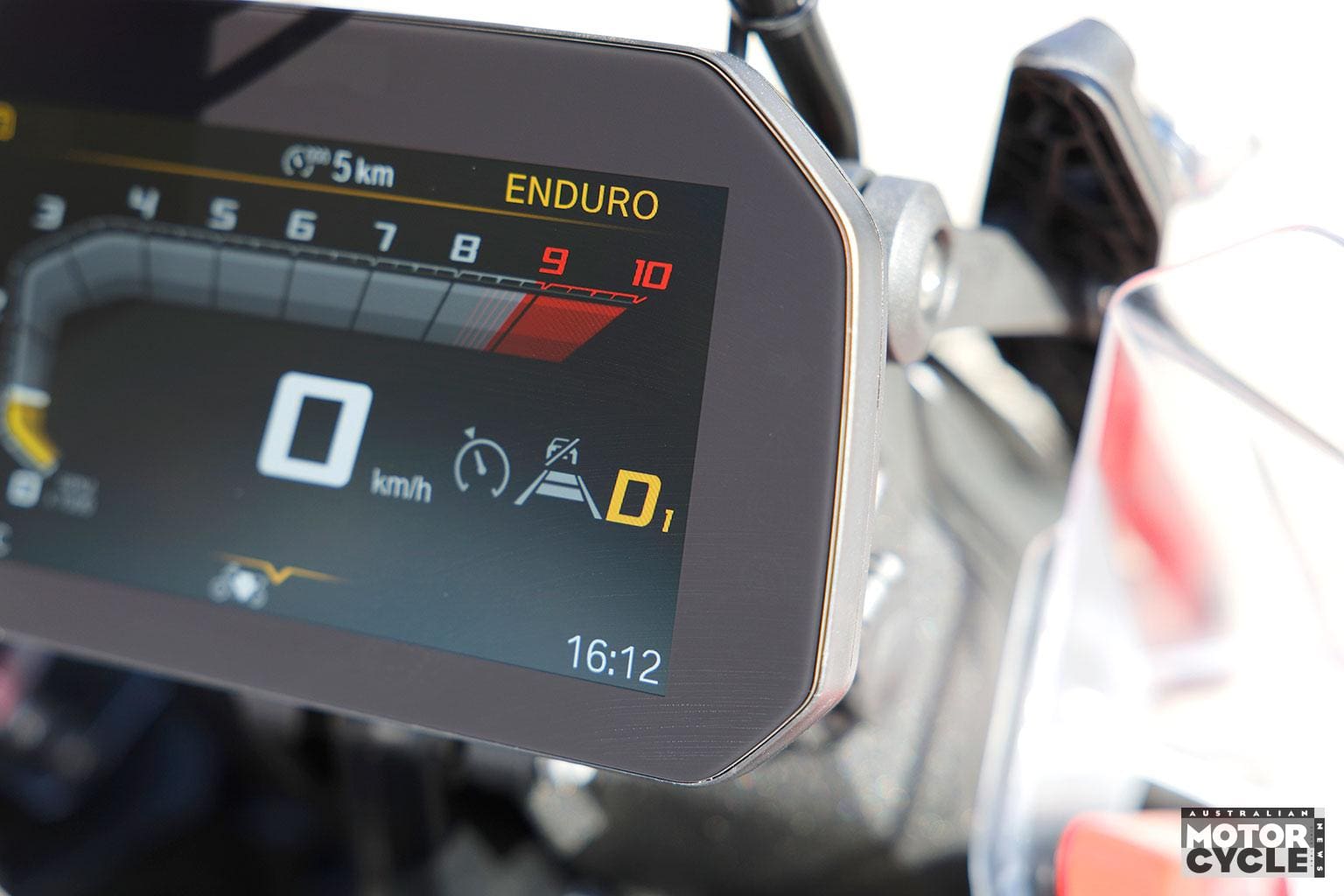
The Karoo 4 rubber tyres cope well on the road, but just when pegs start tickling asphalt you have to remind yourself (again) that you’re on a 269kg machine on heavily off-road-biased rubber – and that the laws of physics can’t be broken. On occasion I could feel the tyres move on their tread blocks, and took it as a warning. All modern GSs are exceptional handlers but it’s asking a lot of a 19-inch front wheel when you dive deep into an apex, braking relatively hard.
That I even tried to push is a massive compliment to the Adventure’s chassis and electronics. The feel transmitted via the DSA suspension is impressive, too, the limit clearly signalled, while the rider aids work quietly in the background. Just to see, I accelerated very hard out of slow corners with the bike banked over to try to provoke a slide. Each time the Dynamic Traction Control (DTC) calmly said no and kept the Adventure driving forward. The TC light illuminated on the dash and I could feel the power reduce – that safety net again expansive and reassuring below my trapeze.
The essence of the Adventure is the way it has been designed to be friendly and easy-going despite its mighty size, although the amount of effort required to make quick direction changes through esses varies depending on which model you are riding, the accessories it has, and the amount of fuel on board. When the fuel levels are at around 15 litres and below, the Adventure’s road manners mirror those of the standard R 1300 GS. But with a full tank of gas, you have to work harder. Hit a switchback section on a mountain road at speed and you physically feel it. Sure, the Adventure can hustle and it is fun but it certainly requires more effort than the standard GS.
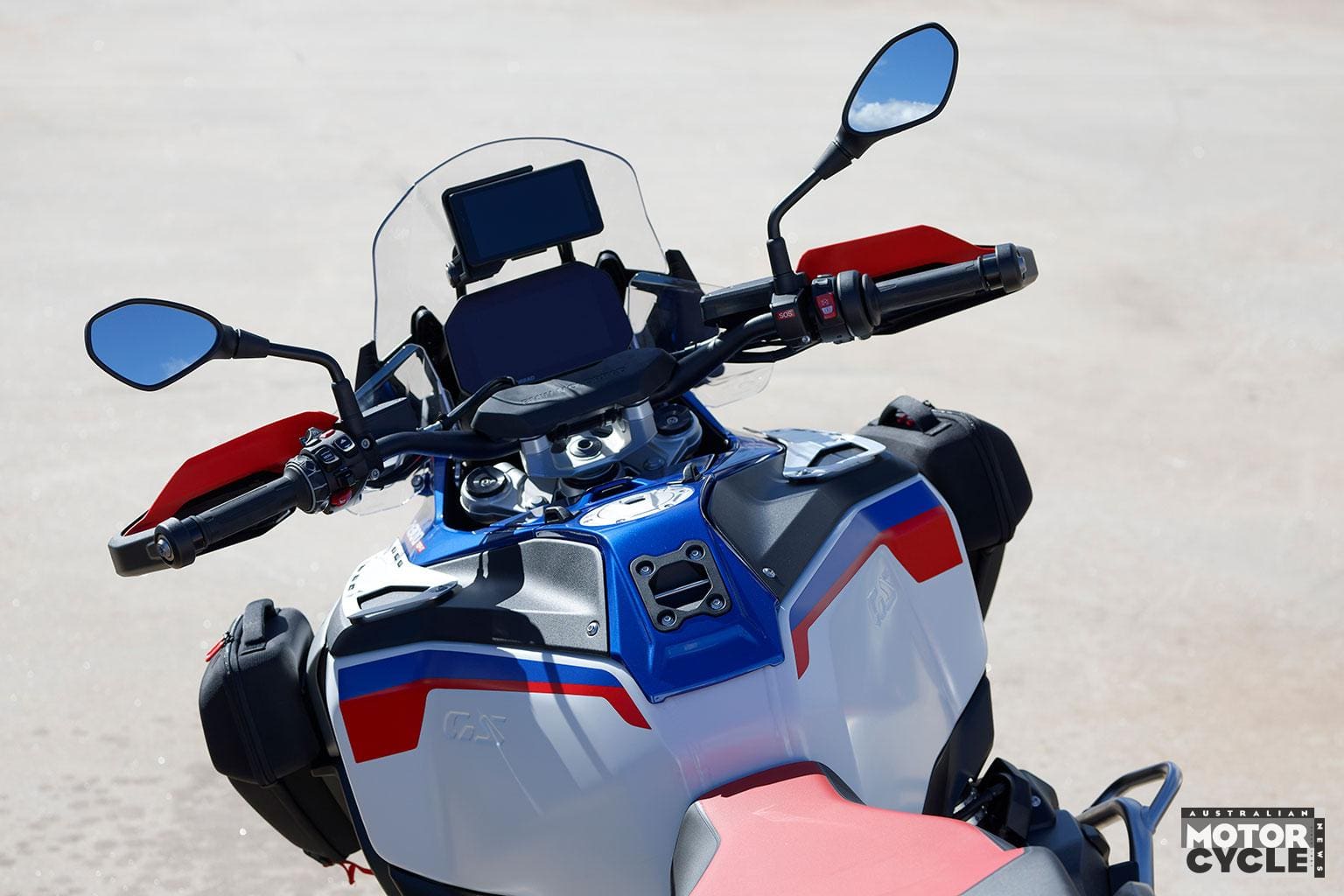
The radial stoppers are carried over from the base GS and have cornering ABS as standard, recalibrated for the Adventure’s different suspension and weight. The four-piston calipers are strong on the road – and you can feel the ABS working from time to time, especially the rear in Road mode – but not as sharp as those on the GS, which has less weight to deal with.
Like the brakes, boxer power is carried over from the R 1300 GS, giving a peak of 107kW (143hp) and 149Nm of torque. As noted, the fuelling is immaculate and, even in Dynamic mode, the Adventure will pull keenly away with the throttle barely opened. Over two days of riding I don’t think I ever got close to the redline; there’s simply no need, given the twin’s luxurious, deep-pile carpet of torque. Gear changes are infrequent; instead, the Adventure flows across the planet, the revs embedded in one of the richest and most flexible of mid-ranges, even during a spirited ride. It will certainly be interesting when we ride the 143hp Adventure against the 170hp Ducati Multistrada V4 – and KTM have an even bigger, more powerful Adventure just around the corner.
On the second day, we rode from Tarifa on the southernmost tip of Spain back to Malaga, with more off-road, as we hugged the coast with Africa in the distance. But soon the romance was over and we had to churn out some big kays on the freeway.
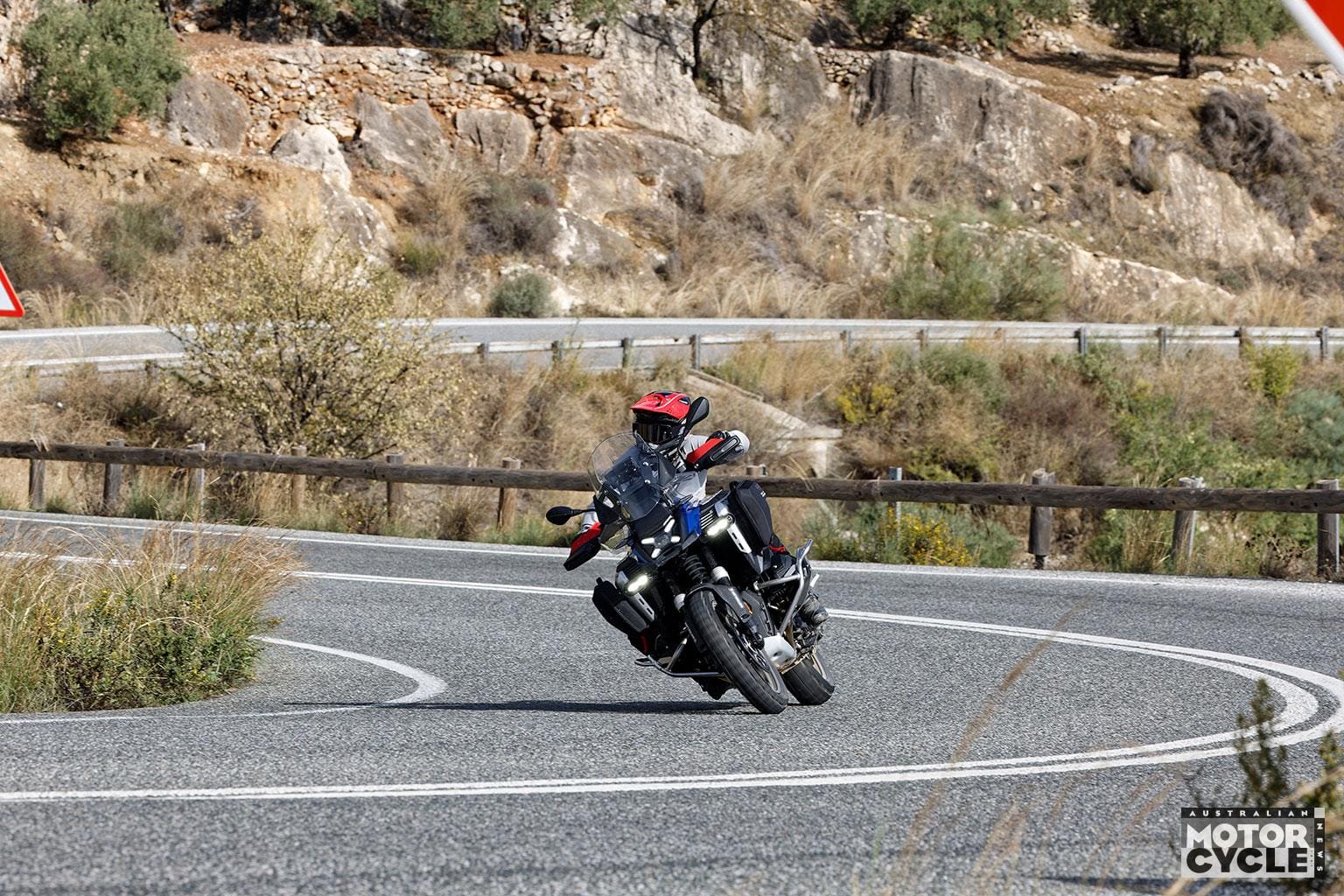
If you want to cover hundreds of miles efficiently and in a blanket of irritation-free comfort, the R1300 GS Adventure might not just be the best adventure bike for the challenge, but the best bike, full stop. Comfort is relentlessly good, especially if you configure your machine with the larger screen, comfort seat and adaptive cruise control. Just sit back and wait for the fuel light to illuminate.
BMW quotes a massive 380-mile range at their claimed 57.6mpg – which is a long old stint between stops in anyone’s book. On test, I averaged 5.7l/100km or just shy of 50mpg, which, considering the abuse it took off-road, wasn’t bad at all. There were lots of off-road trails where I was using only second and third gear and spinning the rear for fun. Ridden properly, BMW’s consumption claim is well within reach. On occasion, the range readout was reading over 650km or over 400 miles, in theory making Lands’ End to John O’Groats, otherwise known as the entire 837-mile length of the UK, doable with just one stop for fuel. The screen on the photographed Trophy model was perhaps a fraction low, and high-mileage tourers should avoid the harder Enduro seat. But those details aside, this is the bike if you want to eat entire countries whole. The big Adventure is hungry for it.
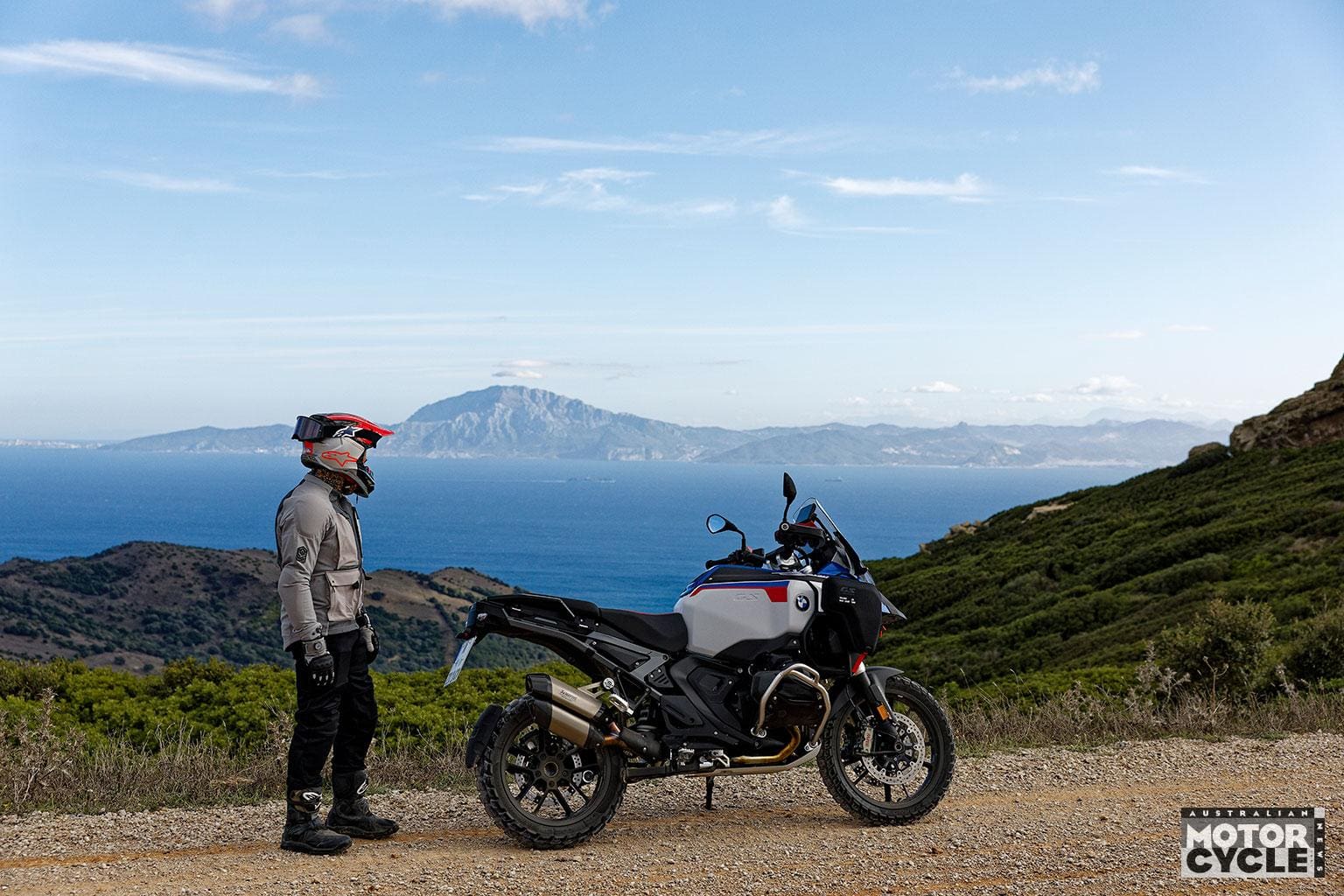
Verdict
BMW was always onto a winner by transforming the already formidable R 1300 GS into the Adventure model. However, they haven’t just slapped a big fuel tank on a GS. Like never before the Adventure feels different from the standard bike – with its own unique personality, appeal and looks. And, trust me on this, it looks pretty good in the flesh.
BMW like to go their own way and have succeeded with the Adventure. The depth of thinking in its design and execution, in its useful features and vast range of accessories, is to be applauded. It is like no other bike on the market.
Yes, it is large and slightly intimidating at first. But isn’t any vehicle capable of smashing across inhospitable terrain and spitting out whole countries before breakfast supposed to have a bit of presence?
A 269kg motorcycle shouldn’t work equally brilliantly both on and off-road, but this one does. It also has exquisite slow-speed balance and perfect fuelling, plus a seat-lowering device that makes it accessible to all. And if its handling and all-day comfort were givens, its usability and the fun you can have on road and dirt and even in town are revelations.
The hard decision for many will be choosing which variant to opt for and which accessory boxes to tick, as this will transform your Adventure. Whether you’re big or small or in between, you can make it fit you like a set of made-to-measure leathers. The only limiting factors are budget and your imagination.
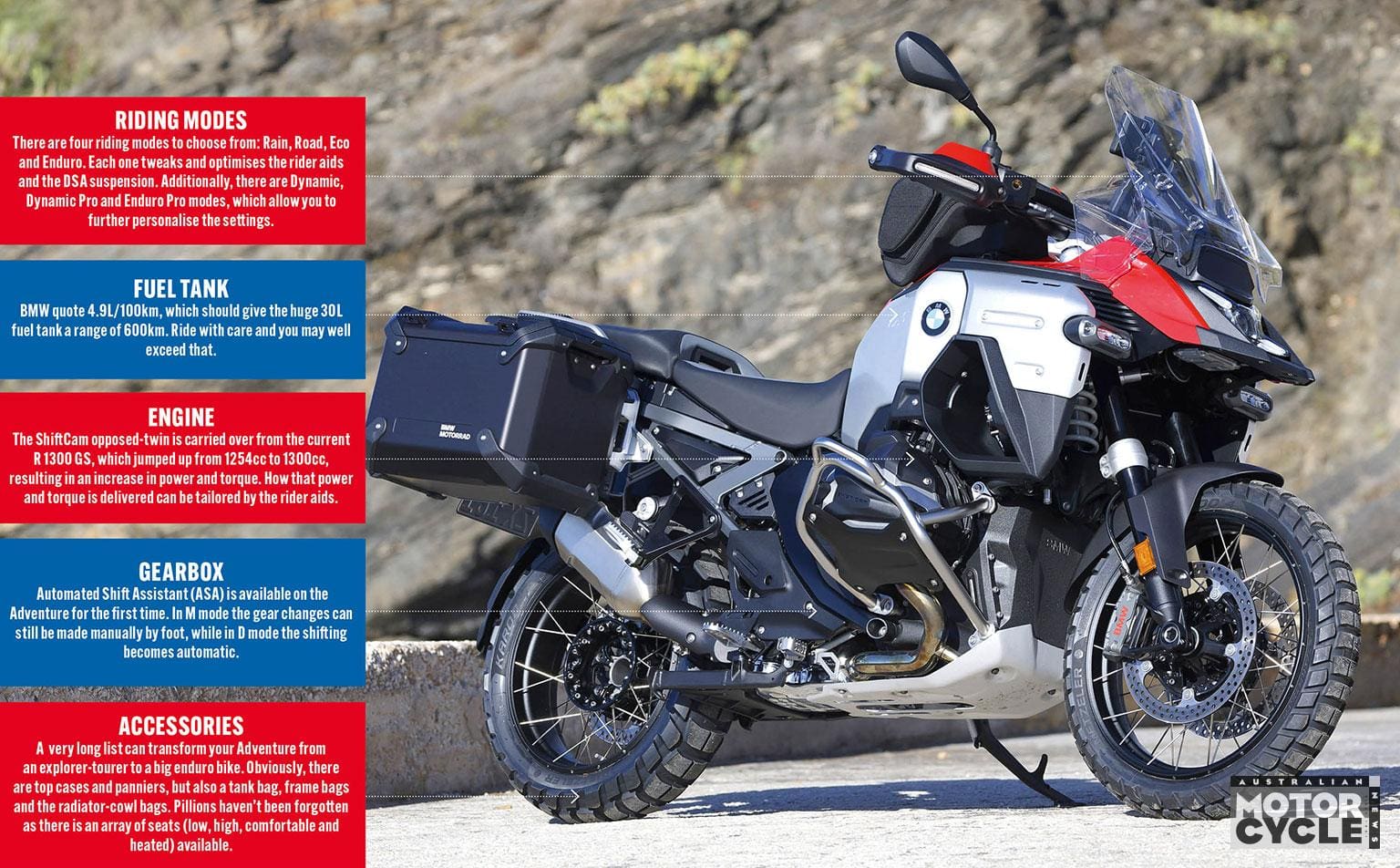
PROS – A 269kg motorcycle shouldn’t work equally brilliantly both on and off-road, but this one does.
CONS – Turn off too many of the rider aids and this big bike could bite you hard.
Specifications

ENGINE
Capacity 1300cc
Type Air/water-cooled, 4 valve per cylinder four-stroke, boxer
Bore stroke 106.5 x 73mm
Compression ratio 13.3:1
Cooling Water/air-cooled
Fueling Electronic fuel injection with Ride-by-Wire
Transmission Six-speed – optional shift assist and semi-auto operation
Clutch Hydraulically activated wet slipper clutch
Final Shaft drive
PERFORMANCE
Power 107kW (143.5hp) @ 7750rpm (claimed)
Torque 149Nm @ 6500 rpm (claimed)
Top speed 240km/h (est)
Fuel consumption 4.9L per 100km
ELECTRONICS
Rider aids Cornering ABS, TC, Hill Start control, Cruise Control with brake function
Rider Modes Four modes standard Road, Rain, Enduro and Eco, optional seven with Dynamic, Dynamic Pro and Enduro Pro
Frame Pressed/welded sheet steel with forged/tubular aluminium subframe
Wheelbase 1534mm
SUSPENSION
Front EVO Telelever Electronic ESA fully adjustable 210mm travel
Rear EVO Paralever Electronic ESA fully adjustable 220mm travel.
WHEELS & BRAKES
Wheels Cast wheels with spokes as an option
Front 3.0 x 19
Rear 4.5 x 17
Tyres Michelin Anakee Adventure/Metzler Tourance Next 2
Front 120/70 X 19
Rear 170/60 x17
Brakes Race Cornering BMW ABS Pro
Front 2 x 310mm discs, radially mounted 4-piston calipers
Rear 285mm disc, two-piston caliper
DIMENSIONS
Weight 269kg (kerb)
Seat height 870-890mm (adjustable)
Width 1012 mm
Length 2280mm
Fuel capacity 30 litres
BUSINESS END
Price from $33,160 ride away
Colour options: Standard, Triple Black, Trophy, Option 719 Tramuntana
Contact
www.bmw-motorrad.com
